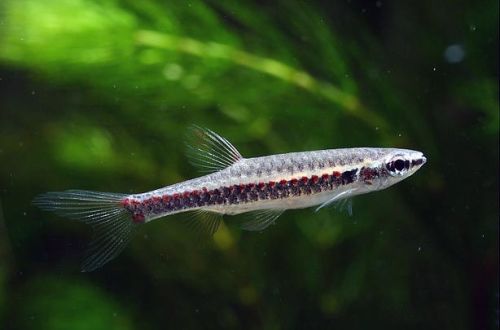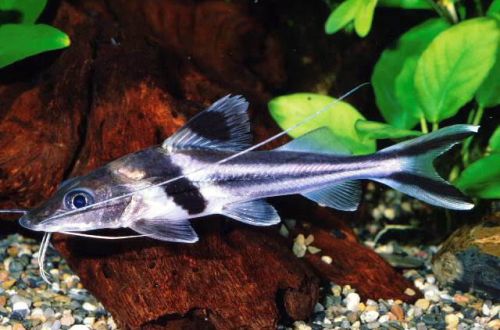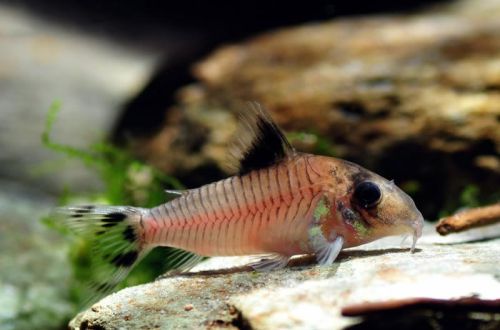
Copeina Natterer
Copella Natterer or Copeina Natterer, scientific name Copella nattereri, belongs to the Lebiasinidae family. A mobile schooling fish, like its other relatives, with an unusual breeding strategy. It is this feature that is often the main argument when choosing it for a home aquarium.

Contents
Habitat
Comes from South America. This species is widely distributed in the upper and middle Amazon basin in Peru and Brazil. Inhabits small streams and channels flowing through dense rainforest. Prefers regions with dense aquatic vegetation and tree foliage hanging over the surface of the water.
Brief information:
- The volume of the aquarium – from 50 liters.
- Temperature – 20-28°C
- Value pH — 4.0–7.5
- Water hardness – soft (1-9 dGH)
- Substrate type – sandy
- Lighting – subdued
- Brackish water – no
- Water movement is weak
- The size of the fish is up to 4 cm.
- Nutrition – any with a combination of live food with herbal supplements
- Temperament – conditionally peaceful, during the spawning period, males may show some hostility
Description
Adult individuals reach a length of about 4 cm. Males, unlike females, are somewhat larger and have enlarged fins. The coloration is silvery with a wide dark horizontal stripe, on top of which red specks are located. With the onset of the mating season, the strip temporarily disappears, and the specks appear brighter.
Food
The basis of the diet should be products rich in protein in the form of flakes, granules, mixtures, as well as live or frozen brine shrimp, daphnia, fruit flies, etc.
Maintenance and care, arrangement of the aquarium
The optimal size of the aquarium for a flock of 8-10 fish starts from 50-60 liters, or a similar size paludarium. Taking into account the characteristics of reproduction (more on this below), the water level should be lower by about 10 cm or more from the edges, and in the design it is desirable to use vegetation that hangs low above the surface. The presence of a lid is mandatory to prevent accidental jumping of fish.
Kopeina Natterer will look most harmoniously among dense thickets of aquatic plants and snags in subdued lighting conditions.
A useful addition may be the leaves of some trees, placed at the bottom. They will serve not so much as a part of the design, but as a means of giving the water a chemical composition similar to that in which fish live in nature. In the process of decomposition, the leaves release tannins, which affect important parameters such as pH and dGH, and at the same time turn the water brown.
Long-term successful management depends on the provision of stable water conditions within an acceptable range of temperatures and hydrochemical values. To this end, regular aquarium maintenance procedures are carried out: they replace the water with fresh water, remove waste, prevent equipment, etc.
Behavior and Compatibility
Peaceful schooling fish. Compatible with many other non-aggressive species of comparable size. It is preferable to maintain a mixed group of at least 8-10 individuals. In the presence of females, males show their best colors, competing with each other.
Breeding / breeding
In a favorable environment, Kopeins readily breed and in a large group, fry can appear with an enviable frequency. The spawning process is different from that of most fish and requires the creation of suitable conditions.
With the onset of the mating season, the male and female form a temporary pair and choose a suitable place to create a clutch, and it will be located outside the water on the surface of a low-hanging leaf. The fish jump out of the water together and stick to the leaf for a short time, during these moments they manage to attach the eggs. After a few jumps, the leaf will be littered with several dozen eggs. At the end of spawning, the female swims away, and the male remains to take care of the clutch. With sharp movements of the tail, it splashes on the eggs, preventing them from drying out.
The incubation period lasts 36-72 hours. From the moment the fry appear, parental care ceases. Juveniles are recommended to be moved to a separate tank in order to avoid predation by adult fish.
If the fish do not have the opportunity to lay eggs above the water, they can lay eggs among the thickets of plants. In this case, the male stays close to them and drives away anyone who may pose a potential threat.
Fish diseases
The main cause of fish health problems are unsuitable conditions of detention, causing a weakening of the immune system and thereby increasing susceptibility to diseases. Read more about symptoms and treatments in the Aquarium Fish Diseases section.





